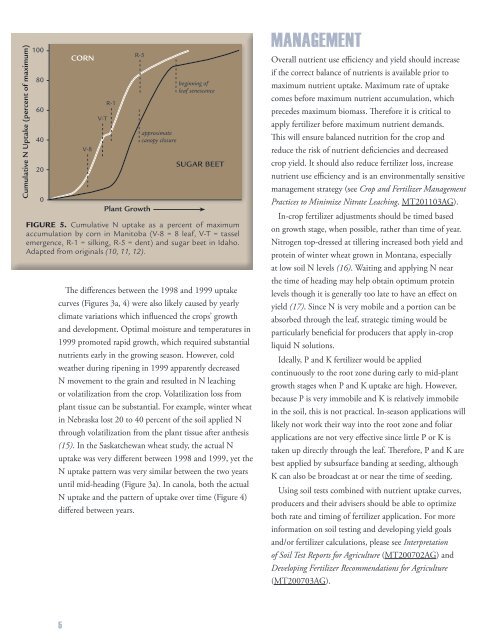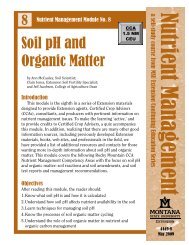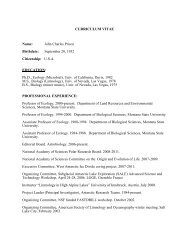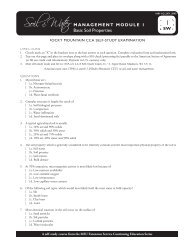Nutrient Uptake Timing by Crops - Department of Land Resources ...
Nutrient Uptake Timing by Crops - Department of Land Resources ...
Nutrient Uptake Timing by Crops - Department of Land Resources ...
Create successful ePaper yourself
Turn your PDF publications into a flip-book with our unique Google optimized e-Paper software.
Cumulative N <strong>Uptake</strong> (percent <strong>of</strong> maximum)<br />
100<br />
80<br />
60<br />
40<br />
20<br />
0<br />
The differences between the 1998 and 1999 uptake<br />
curves (Figures 3a, 4) were also likely caused <strong>by</strong> yearly<br />
climate variations which influenced the crops’ growth<br />
and development. Optimal moisture and temperatures in<br />
1999 promoted rapid growth, which required substantial<br />
nutrients early in the growing season. However, cold<br />
weather during ripening in 1999 apparently decreased<br />
N movement to the grain and resulted in N leaching<br />
or volatilization from the crop. Volatilization loss from<br />
plant tissue can be substantial. For example, winter wheat<br />
in Nebraska lost 20 to 40 percent <strong>of</strong> the soil applied N<br />
through volatilization from the plant tissue after anthesis<br />
(15). In the Saskatchewan wheat study, the actual N<br />
uptake was very different between 1998 and 1999, yet the<br />
N uptake pattern was very similar between the two years<br />
until mid-heading (Figure 3a). In canola, both the actual<br />
N uptake and the pattern <strong>of</strong> uptake over time (Figure 4)<br />
differed between years.<br />
5<br />
CORN<br />
V-8<br />
V-T<br />
R-1<br />
FIGURE 5. Cumulative N uptake as a percent <strong>of</strong> maximum<br />
accumulation <strong>by</strong> corn in Manitoba (V-8 = 8 leaf, V-T = tassel<br />
emergence, R-1 = silking, R-5 = dent) and sugar beet in Idaho.<br />
Adapted from originals (10, 11, 12).<br />
R-5<br />
Plant Growth<br />
approximate<br />
canopy closure<br />
beginning <strong>of</strong><br />
leaf senescence<br />
SUGAR BEET<br />
MANAGEMENT<br />
Overall nutrient use efficiency and yield should increase<br />
if the correct balance <strong>of</strong> nutrients is available prior to<br />
maximum nutrient uptake. Maximum rate <strong>of</strong> uptake<br />
comes before maximum nutrient accumulation, which<br />
precedes maximum biomass. Therefore it is critical to<br />
apply fertilizer before maximum nutrient demands.<br />
This will ensure balanced nutrition for the crop and<br />
reduce the risk <strong>of</strong> nutrient deficiencies and decreased<br />
crop yield. It should also reduce fertilizer loss, increase<br />
nutrient use efficiency and is an environmentally sensitive<br />
management strategy (see Crop and Fertilizer Management<br />
Practices to Minimize Nitrate Leaching, MT201103AG).<br />
In-crop fertilizer adjustments should be timed based<br />
on growth stage, when possible, rather than time <strong>of</strong> year.<br />
Nitrogen top-dressed at tillering increased both yield and<br />
protein <strong>of</strong> winter wheat grown in Montana, especially<br />
at low soil N levels (16). Waiting and applying N near<br />
the time <strong>of</strong> heading may help obtain optimum protein<br />
levels though it is generally too late to have an effect on<br />
yield (17). Since N is very mobile and a portion can be<br />
absorbed through the leaf, strategic timing would be<br />
particularly beneficial for producers that apply in-crop<br />
liquid N solutions.<br />
Ideally, P and K fertilizer would be applied<br />
continuously to the root zone during early to mid-plant<br />
growth stages when P and K uptake are high. However,<br />
because P is very immobile and K is relatively immobile<br />
in the soil, this is not practical. In-season applications will<br />
likely not work their way into the root zone and foliar<br />
applications are not very effective since little P or K is<br />
taken up directly through the leaf. Therefore, P and K are<br />
best applied <strong>by</strong> subsurface banding at seeding, although<br />
K can also be broadcast at or near the time <strong>of</strong> seeding.<br />
Using soil tests combined with nutrient uptake curves,<br />
producers and their advisers should be able to optimize<br />
both rate and timing <strong>of</strong> fertilizer application. For more<br />
information on soil testing and developing yield goals<br />
and/or fertilizer calculations, please see Interpretation<br />
<strong>of</strong> Soil Test Reports for Agriculture (MT200702AG) and<br />
Developing Fertilizer Recommendations for Agriculture<br />
(MT200703AG).







